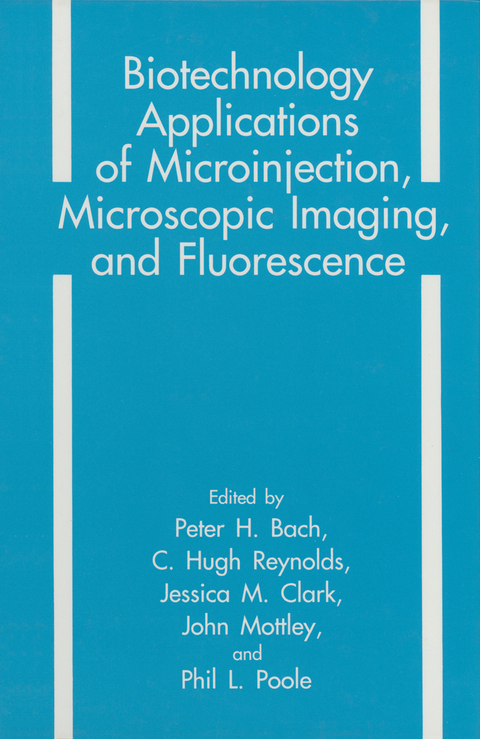
Biotechnology Applications of Microinjection, Microscopic Imaging, and Fluorescence
Springer-Verlag New York Inc.
978-1-4613-6223-4 (ISBN)
Microinjection: A Technique to Study Inhibition of HIV-1 Replication Mediated by Antisense RNA and Parvovirus genes.- How to Make Glass Microtools for the Injection of Isolated Plant Sperm Cells into Embryo Sac Cells Using a Microforge.- Application of the Firefly Luciferase Reporter Gene to Microinjection Experiments in Xenopus Oocytes.- Application of Confocal Microscopy for the Study of Neuronal Organization in Human Cortical Areas After Microinjection of Lucifer Yellow.- The Dye-Transfer Assay Permits the Evaluation of the Modulation of Junctional Communication by Chemicals: Results Obtained Employing a Highly Sensitive Video-Recording System Connected with the Microinjector.- Comparison of Fluorescent Dye Transfer in Intercellular Communication Studies Using Scrape-Loading and Microinjection Techniques.- Characterization of the Zea mays Embryo Sac Using Fluorescent Probes and Microinjection of Lucifer Yellow into the Female Cells.- Fluorescent Probes — Where Do They Go in Cells, and Why?.- Fluorescent Phospholipids in Membrane and Lipoprotein Research.- Selection of Fluorescent Golgi Complex Probes Using Structure-Activity Relationship Models.- Fluorescent Probes for the Assessment of the Subcellular Effects of Chemicals and Disease Processes In Vivo and In Vitro.- Whole-Cell Patch-Clamping: Introducing Substances into Cells During Electrical Measurements from the Cell Membrane: A Review of Potential Difficulties in Plant and Animal Cells.- Fluorescent Analysis of Replication and Intermediates of Chromatin Folding in Nuclei of Mammalian Cells.- Autofluorescence in Potato Tuber Phellum: Location and Time Course of Appearance During Tuber Formation.- Flow Cytometric Assessment of Gentamicin Nephrotoxicity in Established Renal Cell Lines.- The Use of the FluorescentProbe Fura-2 for Intracellular Free Calcium Measurements: Some Methodological Aspects.- Studies on the Effects of Peroxisome Proliferators as Novel Ca2+ Mobilizing Agents using Indo-1-Loaded Hepatocytes.- Confocal Fluorescence Ratio Imaging of pH in Plant Cells.- Analysis of the Calcium and Phosphorus Distribution in Predentine Tissue of Rat Incisors.- Quantitative Localisation of HIV Proteins in Mammalian Cells.- Concepts of the Cytometric Approach.- Laser Microperforation of Medicago sativa Root Hair Cells.- Application of pH-sensitive Fluorescent Dyes to Fungi.- Very Low Level Fluorescence Detection and Imaging Using a Long Exposure Charge Coupled Device System.- Modulation of Nucleus Formation in Mouse Oocytes Fused with Early and Late G2 Blastomeres.
| Zusatzinfo | XI, 255 p. |
|---|---|
| Verlagsort | New York, NY |
| Sprache | englisch |
| Maße | 170 x 244 mm |
| Themenwelt | Medizin / Pharmazie ► Medizinische Fachgebiete ► Pharmakologie / Pharmakotherapie |
| Medizin / Pharmazie ► Pharmazie | |
| Naturwissenschaften ► Biologie ► Biochemie | |
| Naturwissenschaften ► Biologie ► Botanik | |
| Naturwissenschaften ► Biologie ► Zoologie | |
| Technik ► Umwelttechnik / Biotechnologie | |
| ISBN-10 | 1-4613-6223-7 / 1461362237 |
| ISBN-13 | 978-1-4613-6223-4 / 9781461362234 |
| Zustand | Neuware |
| Haben Sie eine Frage zum Produkt? |
aus dem Bereich


